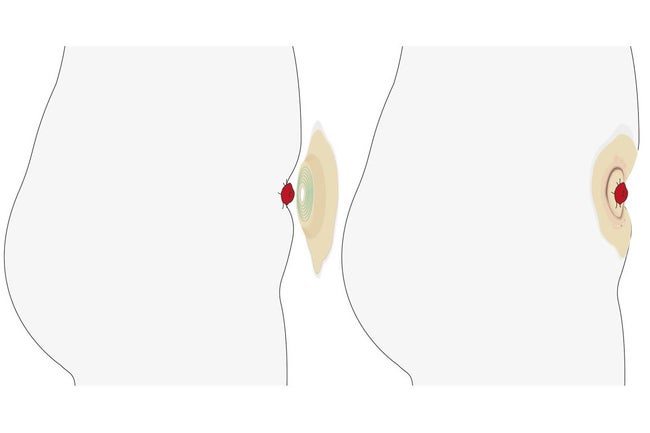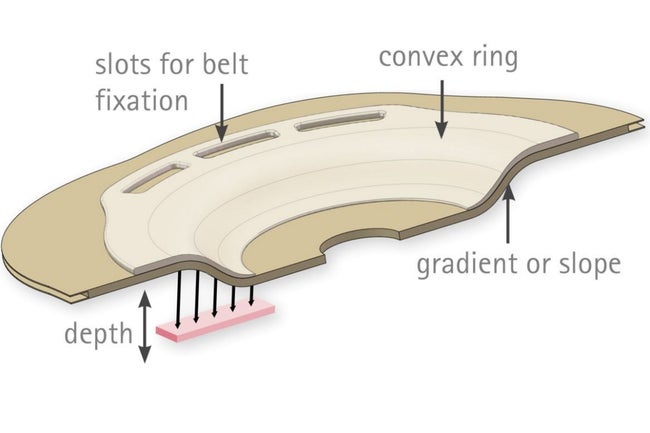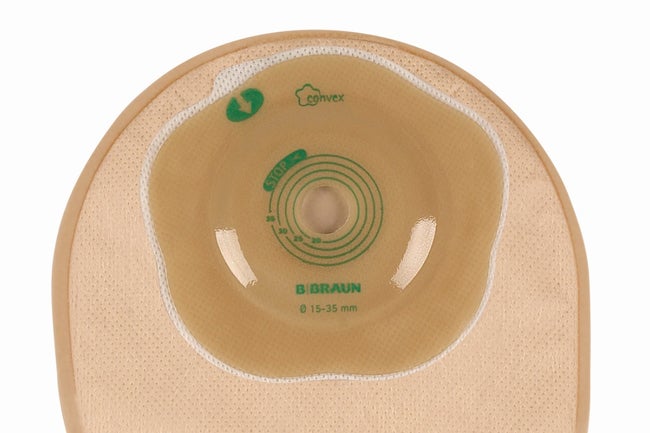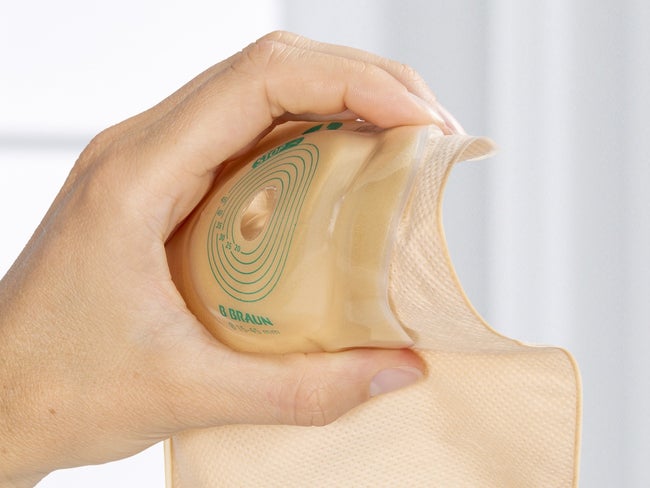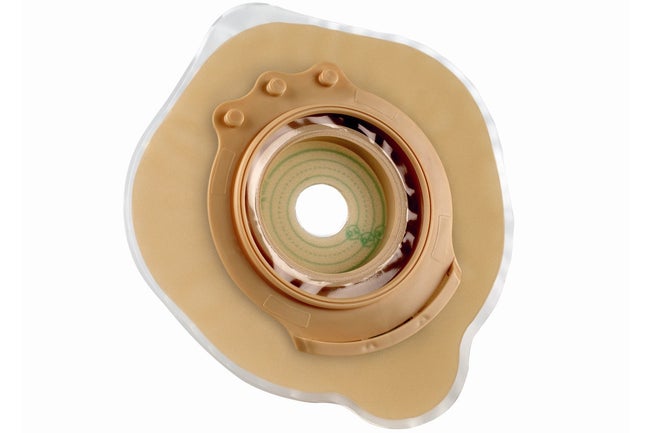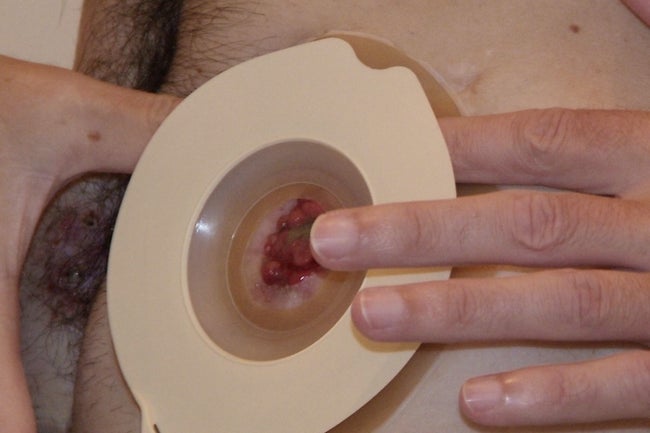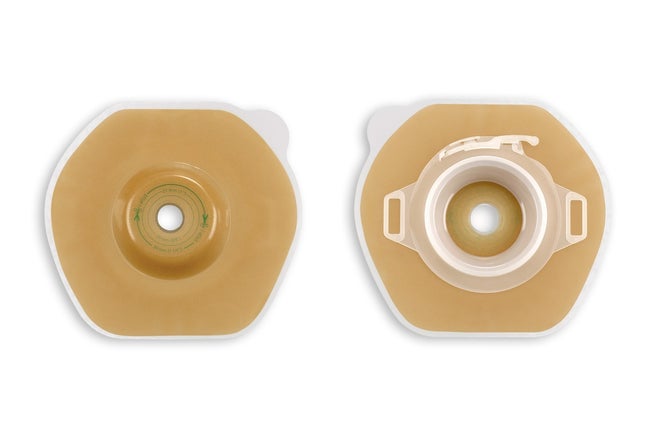Advantages of convex ostomy bag systems
The purpose of a convex ostomy bag system is to ensure a good seal of the appliance to the surrounding skin to prevent stoma leakages, which is one of the most frequent challenges in stoma care.
The ideal convex ostomy bag system should
- apply sufficient pressure around the stoma to smooth out the peristomal contours, especially in creases and skin folds, to ensure the skin protector or wafer forms a tight seal with the skin.
- exert the right amount of pressure onto the peristomal skin, to allow the stoma to protrude further inside the bag. This improves the drainage of stoma effluents into the bag and is especially helpful with retracted or flush ostomies.
- avoid sustained pressure that could damage the stoma and the surrounding skin.
- be flexible enough to adhere to and form a seal with the patient’s body profile while ty move and change posture.
- make accessories such as convex barrier rings unnecessary.
- be comfortable for the stoma patient.(1)
When should you suggest a convex stoma system?
Especially if your patient suffers from stoma leakage, it may be reasonable to recommend and prescribe a convex stoma appliance. This decision should be based on an assessment of both the nature of the stoma as well as the patient’s abdomen and its contour. Such an assessment is necessary and particularly important in the early postoperative period. This should not be limited merely to ascertaining the correct size of the skin protector or wafer. Ideally, the patient is assessed in different positions such as lying, sitting, and standing.(2)
Ultimately, it is your clinical experience which determines whether or not you recommend a convex system to your patient. If you decide to recommend the use of a convex system, regular re-evaluation is suggested, as improper use can lead to complications.
Convex appliances may be appropriate for(2/3)
- flush or retracted ostomies, especially in conjunction with liquid stoma discharge
- peristomal contour with skin folds, creases, wrinkles, scars, channels or flaccidness of the abdomen (can also be used with a well-protruded stoma)
- an unfavorably located stoma os, e.g. if the os tilts downward or is at skin level
- loop ostomies
- prolapsed or telescoping stomas
- stomas with high output or stomas with liquid outflow so as to increase the wear time of the wafer or skin protector. Liquid discharge seeps into smaller gaps in the skin more easily than formed stool and crosses the skin barrier faster, even in well-protruded stomas.
Different convex systems to fit patients’ needs
The appliance must be adapted both to the dynamics and conditions of the patient’s abdomen and to the characteristics of their stoma. That is why convex stoma bag systems differ in depth, profile (gradient or slope), tension or pressure, firmness, softness and flexibility.(2)
A stoma belt can be used to intensify the effect of convexity.(3)
B. Braun offer: one-piece convex bag systems
Flexima®
- Skin protector with medium convexity
- Convexity of 4 mm in depth
- Gentle slope for good pressure distribution
- For slightly retracted to retracted stomas
- Three slots or loops on each side of the skin protector ring for belt fixation: They give the patient the option to wear the bag at an angle and not only straight down to the bottom.
Flexima Convex Range
Flexima® Active O'Convex
- Skin protector with soft convexity
- Convexity of 6 mm in depth
- Skin protector with gentle slope designed to ensure an optimum seal around the stoma
- Skin protector designed to combine flexibility and easy removal
- For flush or slightly retracted stomas
- Three loops on each side of the skin protector ring for belt fixation: They give the patient the option to wear the bag at an angle and not only straight down to the bottom.
Flexima® Active Range
B. Braun offer: two-piece convex bag systems
Flexima® 3S with mechanical coupling system
- Wafer with medium convexity
- Convexity of 6 mm in depth with gentle slope
- Convexity designed for good pressure distribution
- Guided coupling system for precise, simple and safe bag positioning on the wafer
- For slightly retracted to retracted stomas
- Three loops on each side of the bag ring for belt fixation: They give the patient the option to wear the bag at an angle and not only straight down to the bottom.
Flexima® 3S Range
Flexima® Key with adhesive coupling system
- Wafer with medium convexity
- Convexity of 4mm in depth with gentle slope
- Guided coupling system for precise, simple and safe bag positioning on the wafer without the need of pressure application
- For slightly retracted to retracted stomas
- Three loops on each side of the wafer for belt fixation: They give the patient the option to wear the bag at an angle and not only straight down to the bottom.
Flexima® Key Range
Proxima® 2+ with mechancical coupling system
- Convexity of 8 mm in depth
- Coupling system with minimum pressure on the abdomen
- For retracted stoma
- One loop on each side of the wafer for belt fixation
Proxima® 2 Range
References:
1) Cronin, E. A guide to the appropriate use of convex stoma care products. Gastrointestinal Nursing. 2008 6:2, 12-16
2) Haeflok J, Kittscha J, Purnell P. Use of Convexity in Pouching. A Comprehensive Review. Journal of Wound, Ostomy and Continence Nursing. 2013
3) Hoeflok J, Salvadalena G, Pridham S, Droste W, McNichol L, Gray M. Use of Convexity in Ostomy Care: Results of an International Consensus Meeting. J Wound Ostomy Continence Nurs. 2017;44(1):55-62. doi: 10.1097/WON.00000000000002914
